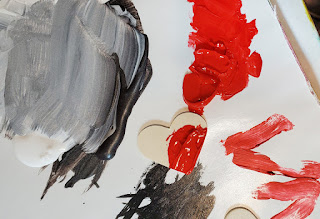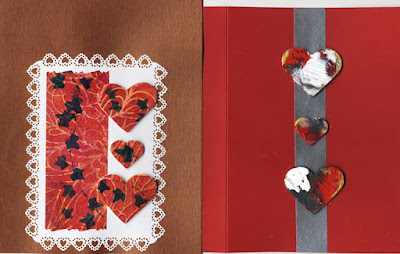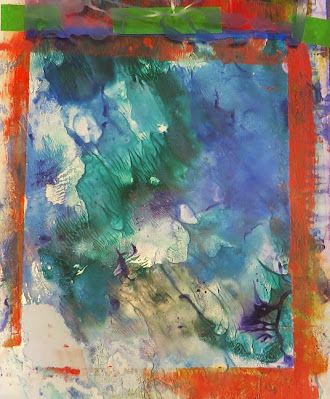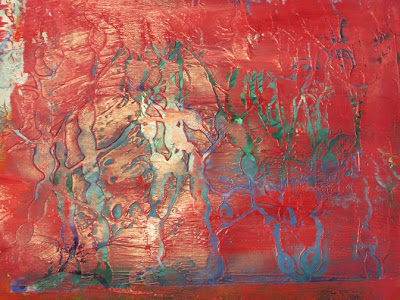Space restrictions meant that my January 28 post at StencilGirl Talk had to have some photos deleted. I'm re-posting the original version here today, since a picture's worth a thousand words....
Have a heart! Or
two. Or five. Or a dozen!
Getting ready for Valentine’s Day? Or any other occasion you want to brighten with hearts?
I use leftovers in creating three-dimensional heart
embellishments for greeting cards, memo magnets, hanging ornaments, art journal
cover decoration, lapel pins, earrings, etc.
Today I’m describing two approaches. First I’ll talk about leftover acrylic
paints. Secondly, I’ll show a way to use
leftover stencil-printed papers.
My first project starts with wooden craft hearts…
…and a painting in progress:
In this painting project, as shown in the two photos directly above, I’m using 6” x 6” StencilGirl® Pavilion Shadows with heavy-body black acrylic paint and 6” x 6” StencilGirl® Ski Lift Works with heavy-body red acrylic paint. Dollops of these paints, as well as heavy-body gold and white acrylic paints, are waiting on my tablet of disposable palette paper (a tablet of white paper with a glossy, resist-surface.)
After I’m done using paints for my painting-in-progress, I place wooden craft hearts into the leftover dollops of wet paint. When I lift them, they’re partially coated with paint that boasts a delightful 3-dimensional “squished” pattern --
Next, I double-dip each heart to load it with a second color.
I repeat this till all leftover paints are used.
After my first set of hearts dry, they’re ready to become
embellishments on a Valentine greeting card that will appear at the end of this
post.
More newly-dry painted hearts are going a step further – into bling! After placing them in a beading tray, I add glitter glue and miniature iridescent beads.
Most of my bling-hearts, used as embellishments, will appear at the close of this post. But I’m showing one here; among its randomly-tilted layers is a heart cut from a stencil-print. Stencil used: 6” x 6” StencilGirl® Marbles 6.
My second way to use leftovers starts with scraps of stencil-printed papers. Today’s example is a foil scrap printed with 6” x 6” ” StencilGirl® Swatton Links.
I flip the scrap backside-up and freehand-draw 2 hearts. Or you can use wooden hearts as tracing templates.
After cutting out the heart shapes, I glue them to a Valentine card atop a lace doily from InLoveArts.
I have another paper that was left over from an earlier project, when I’d printed it using 6” x 6” ” StencilGirl® Sprigs and 6” x 6” StencilGirl® Ivy Frame 6 Stencil.
From this paper scrap, I cut a column to place on a card. After gluing a number of craft wooden hearts to the back of the remaining scrap, I start to cut them out so I can glue them to the Valentine with the column, as well as other Valentines.
Here are today’s finished greeting cards --
What about that painting-in-progress? Having developed into a mixed-media collage, it’s below:
Below are 3 close-up detail photos of the artwork's stenciled areas....
1. Stencil used: 6" x 6" Pavilion Shadows s464
Note: To mail
greeting cards with 3-dimensional embellishments, I recommend using padded
envelopes. You can find US
postal requirements here.
Want a supply list for today’s 2-prong project? You can find that by scrolling back here on my post to January 28, 2021.
To scroll thru the pages of my StencilGirl® stencils
and masks, please start here.



















































